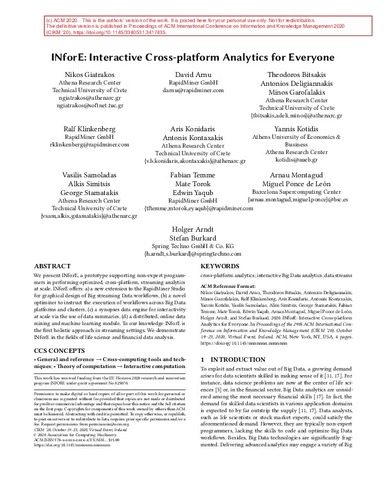Exploració per autor "Simitsis, Alkis"
Ara es mostren els items 4-11 de 11
-
Incremental consolidation of data-intensive multi-flows

Jovanovic, Petar; Romero Moral, Óscar; Simitsis, Alkis; Abelló Gamazo, Alberto (2016-05-01)
Jovanovic, Petar; Romero Moral, Óscar; Simitsis, Alkis; Abelló Gamazo, Alberto (2016-05-01)
Article
Accés obertBusiness intelligence (BI) systems depend on efficient integration of disparate and often heterogeneous data. The integration of data is governed by data-intensive flows and is driven by a set of information requirements. ... -
INforE: Interactive cross-platform analytics for everyone

Giatrakos, Nikos; Arnu, David; Bitsakis, Theodoros; Deligiannakis, Antonios; Garofalakis, Minos; Klinkenberg, Ralf; Konidaris, Aris; Kontaxakis, Antonis; Kotidis Kotidis, Yannis; Samoladas, Vasilis; Simitsis, Alkis; Stamatakis, George; Temme, Fabian; Torok, Mate; Yaqub, Edwin; Montagud, Arnau; Ponce De Leon, Miguel; Arndt, Holger; Burkard, Stefan (Association for Computing Machinery (ACM), 2020-10)
Giatrakos, Nikos; Arnu, David; Bitsakis, Theodoros; Deligiannakis, Antonios; Garofalakis, Minos; Klinkenberg, Ralf; Konidaris, Aris; Kontaxakis, Antonis; Kotidis Kotidis, Yannis; Samoladas, Vasilis; Simitsis, Alkis; Stamatakis, George; Temme, Fabian; Torok, Mate; Yaqub, Edwin; Montagud, Arnau; Ponce De Leon, Miguel; Arndt, Holger; Burkard, Stefan (Association for Computing Machinery (ACM), 2020-10)
Comunicació de congrés
Accés obertWe present INforE, a prototype supporting non-expert programmers in performing optimized, cross-platform, streaming analytics at scale. INforE offers: a) a new extension to the RapidMiner Studio for graphical design of Big ... -
Integrating ETL processes from information requirements

Romero Moral, Óscar; Jovanovic, Petar; Simitsis, Alkis; Abelló Gamazo, Alberto (Springer, 2012)
Romero Moral, Óscar; Jovanovic, Petar; Simitsis, Alkis; Abelló Gamazo, Alberto (Springer, 2012)
Text en actes de congrés
Accés restringit per política de l'editorialData warehouse (DW) design is based on a set of requirements expressed as service level agreements (SLAs) and business level objects (BLOs). Populating a DW system from a set of information sources is realized with ... -
Quarry : digging up the gems of your data treasury

Jovanovic, Petar; Romero Moral, Óscar; Simitsis, Alkis; Abelló Gamazo, Alberto; Candón Arenas, Héctor; Nadal Francesch, Sergi (2015)
Jovanovic, Petar; Romero Moral, Óscar; Simitsis, Alkis; Abelló Gamazo, Alberto; Candón Arenas, Héctor; Nadal Francesch, Sergi (2015)
Comunicació de congrés
Accés obertThe design lifecycle of a data warehousing (DW) system is primarily led by requirements of its end-users and the complexity of underlying data sources. The process of designing a multidimensional (MD) schema and back-end ... -
Requirement-driven creation and deployment of multidimensional and ETL designs

Jovanovic, Petar; Romero Moral, Óscar; Simitsis, Alkis; Abelló Gamazo, Alberto (Springer, 2012)
Jovanovic, Petar; Romero Moral, Óscar; Simitsis, Alkis; Abelló Gamazo, Alberto (Springer, 2012)
Text en actes de congrés
Accés obertWe present our tool for assisting designers in the error-prone and time-consuming tasks carried out at the early stages of a data warehousing project. Our tool semi-automatically produces multidimensional (MD) and ETL ... -
Semantic web technologies for business intelligence

Berlanga, Rafael; Romero Moral, Óscar; Simitsis, Alkis; Nebot, Victoria; Pedersen, Torben; Abelló Gamazo, Alberto; Aramburu, María José (IGI Global, 2011)
Berlanga, Rafael; Romero Moral, Óscar; Simitsis, Alkis; Nebot, Victoria; Pedersen, Torben; Abelló Gamazo, Alberto; Aramburu, María José (IGI Global, 2011)
Capítol de llibre
Accés restringit per política de l'editorialThis chapter describes the convergence of two of the most influential technologies in the last decade, namely business intelligence (BI) and the Semantic Web (SW). Business intelligence is used by almost any enterprise to ... -
Using semantic web technologies for exploratory OLAP: A survey

Abelló Gamazo, Alberto; Romero Moral, Óscar; Pedersen, Torben; Berlanga, Rafael; Nebot, Victoria; Aramburu, María José; Simitsis, Alkis (2015-02-01)
Abelló Gamazo, Alberto; Romero Moral, Óscar; Pedersen, Torben; Berlanga, Rafael; Nebot, Victoria; Aramburu, María José; Simitsis, Alkis (2015-02-01)
Article
Accés obert -
xPAD: A platform for analytic data flows

Simitsis, Alkis; Wilkinson, Kevin; Jovanovic, Petar (2013)
Simitsis, Alkis; Wilkinson, Kevin; Jovanovic, Petar (2013)
Text en actes de congrés
Accés restringit per política de l'editorialAs enterprises become more automated, real-time, and data-driven, they need to integrate new data sources and specialized processing engines. The traditional business intelligence architecture of Extract-Transform-Load ...






